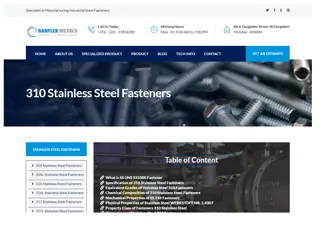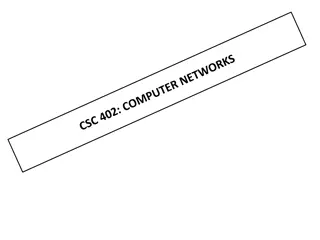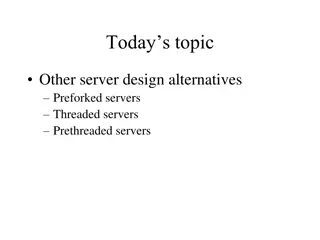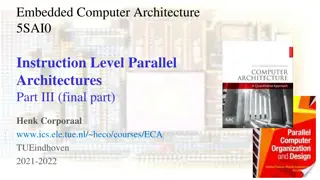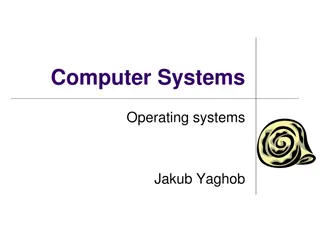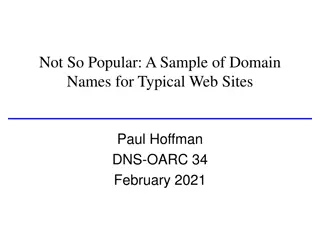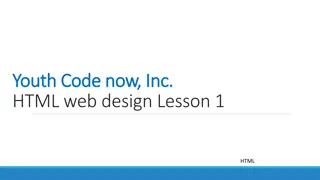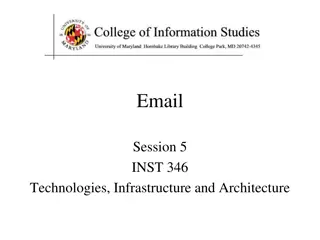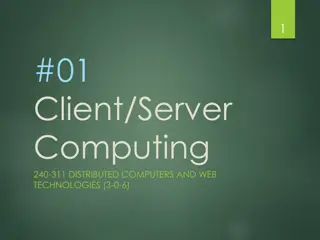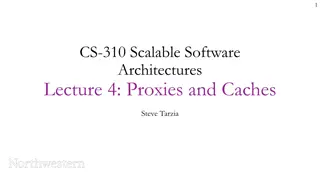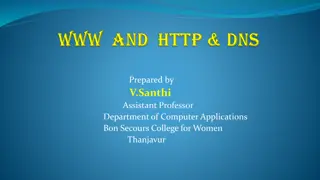CS-310 Scalable Software Architectures Lecture on HTTP and Web Servers
This lecture covers the fundamental concepts of scaling software services, distinguishing between programs and services, network translation, service threading, concurrency, and web/HTTP server frameworks. Vertical and horizontal scaling approaches are explained, highlighting the essence of handling multiple concurrent requests efficiently.
Download Presentation

Please find below an Image/Link to download the presentation.
The content on the website is provided AS IS for your information and personal use only. It may not be sold, licensed, or shared on other websites without obtaining consent from the author.If you encounter any issues during the download, it is possible that the publisher has removed the file from their server.
You are allowed to download the files provided on this website for personal or commercial use, subject to the condition that they are used lawfully. All files are the property of their respective owners.
The content on the website is provided AS IS for your information and personal use only. It may not be sold, licensed, or shared on other websites without obtaining consent from the author.
E N D
Presentation Transcript
1 CS-310 Scalable Software Architectures Lecture 2: HTTP and Web Servers Steve Tarzia
Last Time: Types of Scaling A software service is a program that runs continuously, giving responses to requests. Scalability is the ability of a service to grow to handle many concurrent users (ideally an arbitrarily large number). Two approaches to scaling that are useful in different scenarios: Vertical scaling is upgrading your machine(s). The simplest and most efficient way of scaling but there is a ceiling. Horizontal scaling is adding more machines. Coordinating a cluster of machines is complicated, but it's necessary for global scale and massive throughput.
3 How are services different than programs? STOP and THINK
4 Basic Service Definition In the theory of computation, a computer program (Turing Machine) takes a symbolic input and returns a symbolic output. Then it stops. Similarly, a computer service receives requests and returns a response for each request. However, a service can handle many concurrent, independent requests, which may be from different users.
5 Network From a Program to a Service A simple computer program can be translated into a service by: Listening to requests that arrive from the network. Running many copies of the program concurrently (using the OS features called threads or processes). Using queues to store unhandled requests and unsent responses. Queues allow competing threads to share a single network socket (one IP address and port).
6 Service thread The program on each thread runs an infinite loop: while(true){ request = requestQ.pop(); response = doWork(request); responseQ.push(response); } push pop pop() waits if the queue is empty. push() might wait if queue is too full. A thread that waits is also said to block.
7 Concurrency Many requests can be processed at the same time (concurrently). This allows many CPU cores to be used in parallel. The threaded design is also helpful even if there is only one CPU core, because the app may block to request data from disk or over the network. This is called IO (input/output). While one thread is waiting for the IO to complete, another can use the CPU.
8 Web/HTTP server frameworks Web/HTTP server software provides this basic framework. For example: Java: Jetty, Tomcat Python: Flask, Django Javascript: Node.js Static files: Apache httpd, Nginx Just plug in the app code.
Hyper Text Transport Protocol (HTTP) HTTP is a client-server data exchange protocol It was invented for web browsers to fetch pages from webservers Request specifies: A human-readable header with: URL, method, (plus some optional headers) An optional body, storing raw data (bytes). Response includes: A human-readable header with response code, (plus some optional headers) An optional body
Request: (optional for GET) Response: From https://www.ntu.edu.sg/home/ehchua/pro gramming/webprogramming/HTTP_Basics. html
11 Wikipedia architecture Main application is MediaWiki 70% PHP, 30% JavaScript Databases are MariaDB (SQL) https://meta.m.wikimedia.org/wi ki/Wikimedia_servers
12 Key parts Squid: Caching HTTP proxy on frontend. Apache httpd: web servers running the main application (MediaWiki) SQL databases for wiki text, etc. File servers for images.
13 Key parts HTTP cache MediaWiki Your browser
14 Caching layer is optional! We ll come back to caching in the next lecture MediaWiki Your web browser
15 MediaWiki application Runs PHP code in Apache Httpd web framework. Input request: An HTTP request from the browser. For example, GET /wiki/Embioptera Output response: An HTTP response understandable to the browser. Usually an HTML document, sometimes an image, etc.
16 MediaWiki s main task is to generate article HTML How? Get corresponding wiki text from DB. Translate wiki text to HTML. Add wrapping content and banners. Add user-specific page header, based on cookies in request.
17 MediaWiki s main task is to generate article HTML How? Get corresponding wiki text from DB. Translate wiki text to HTML. Add wrapping content and banners. Add user-specific page header, based on cookies in request.
18 MediaWiki s main task is to generate article HTML How? Get corresponding wiki text from DB. Translate wiki text to HTML. Add wrapping content and banners. Add user-specific page header, based on cookies in request.
19 MediaWiki s main task is to generate article HTML How? Get corresponding wiki text from DB. Translate wiki text to HTML. Add wrapping content and banners. Add user-specific page header, based on cookies in request.
Code walkthroughs (Bitbucket links will not work for students, refer to video) https://stevetarzia.com/ https://bitbucket.org/starzia/www.stevetarzia.com/src/master/index.php?mode=view&spa=0&at=master &fileviewer=file-view-default https://stevetarzia.com/xmas/ https://bitbucket.org/starzia/www.stevetarzia.com/src/master/xmas/index.php?mode=view&spa=0&at= master&fileviewer=file-view-default https://stevetarzia.com/listen/ https://bitbucket.org/starzia/www.stevetarzia.com/src/master/listen/index.php?mode=view&spa=0&at= master&fileviewer=file-view-default https://gunmemorial.org/donate https://bitbucket.org/starzia/gunmemorial/src/master/victim- portal/src/main/webapp/donate.jsp?mode=view&spa=0&at=master&fileviewer=file-view-default https://gunmemorial.org/sitemap.txt https://gunmemorial.org/sitemap.txt?startYear=2020&endYear=2020 https://bitbucket.org/starzia/gunmemorial/src/master/victim- portal/src/main/java/org/gunmemorial/web/servlet/SiteMapServlet.java?mode=view&spa=0&at=master &fileviewer=file-view-default
Recap Showed that web server frameworks let you translate a simple program into a multi-threaded service with concurrency. Introduced HTTP as the most common type of service. Client requests a document (specified in path/url) Server sends document in the response. High-level overview of Wikipedia s architecture. Open questions: What s caching and why is it possible? What s the purpose of the database and how to make it scalable?


